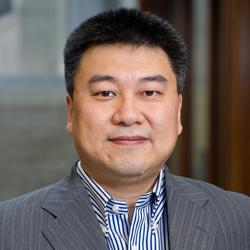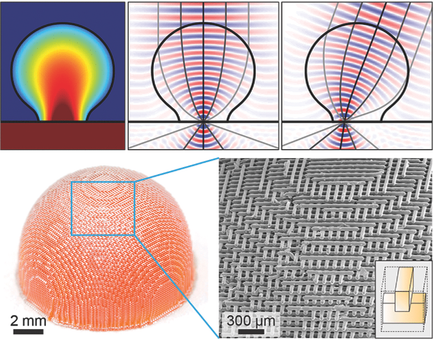The Illinois-based Northwestern University has utilized 3D printing technology to research a variety of vital applications, from 3D printing fuel cells to 4D printing materials on the nanoscale. Now, researchers from the prestigious institution are looking at 3D printing technology through a unique lens—a terahertz lens, to be exact. Generally unknown within the electromagnetic spectrum, hidden in between the more commonly known wavelengths of microwaves and infrared, lies the information-packed terahertz spectrum. The terahertz is not only a forgotten frequency, it’s also rarely studied, let alone well understood, yet it has high value in applications regarding imaging and communications.
One research group, led by Northwestern University’s Cheng Sun, has used metamaterials and a unique style of SLA technology called projection micro-stereolithography to manufacture a novel lens capable of working with terahertz frequencies. The 3D printed terahertz gradient-refractive index lens has better imaging capabilities than other commonly used lenses, and also enables researchers to make more advances with the relatively unknown world of the terahertz.
The micro-3D printing technique used in the research granted the team the ability to produce the miniaturized features needed to operate at the terahertz frequency band. The specialized 3D printer allowed Sun and his colleagues to accomplish the fabrication of this lens in a scalable, quick, and inexpensive manner. The material used to 3D print the terahertz lens, which is a novel metamaterial equipped with properties not generally found in nature, is able to accurately form into the preemptive lens design using the projected light.
“For printing, we use a photo-polymer in liquid form,” Sun said. “When we shine a light on the material, it converts it into a solid. The material forms to the shape of the light, allowing us to create a 3-D structure. You cannot accomplish a gradient index with traditional manufacturing processes.”
 The 3D printed lens holds potential for a number of applications, particularly those that are security-related. Not only can this alternative be a cheaper and higher resolution option, but it can also detect more than even X-ray technology, which is confined to metals. With a terahertz scanner, the device can also detect plastics and chemicals, and can help monitor a number of threats, such as biological weapons and plastic explosives. Not only can this unique frequency help improve the means for security, but unlike X-rays, terahertz radiation deals absolutely no harm to the human body.
The 3D printed lens holds potential for a number of applications, particularly those that are security-related. Not only can this alternative be a cheaper and higher resolution option, but it can also detect more than even X-ray technology, which is confined to metals. With a terahertz scanner, the device can also detect plastics and chemicals, and can help monitor a number of threats, such as biological weapons and plastic explosives. Not only can this unique frequency help improve the means for security, but unlike X-rays, terahertz radiation deals absolutely no harm to the human body.
On April 21, 2016, the study, entitled “Additive Manufacturing of a 3D Terahertz Gradient-Refractive Index Lens,” was published in the journal Advanced Optical Materials. One of the study collaborators, Oklahoma State University’s Wei Cao, believes that their research will help us retain high resolution information from certain opaque materials, and can potentially improve a wide range of industries, from biomedical research to security purposes. Other researchers involved in the study, aside from Cao and Sun, include Fan Zhou, Biqin Dong, Timothy Reissman, and Weili Zhang.
Though this is a vital and unique discovery, it’s not the first time 3D printing technology was used for this purpose. Last year, a group of Chinese researchers from the Huazhong University of Science and Technology conducted a similar study, also 3D printing a lens capable of focusing on terahertz frequencies. Discuss your thoughts and ideas regarding this technology further in the 3D Printed Terahertz Lens forum over at 3DPB.com.
[Source: R&D Mag / Images: R&D Mag and Advanced Optical Material]Subscribe to Our Email Newsletter
Stay up-to-date on all the latest news from the 3D printing industry and receive information and offers from third party vendors.
Print Services
Upload your 3D Models and get them printed quickly and efficiently.
You May Also Like
Consolidation in AM: How 2025 Is Shaping the Industry’s New Normal
The first half of 2025 has been marked by a clear shift in the additive manufacturing (AM) industry. Companies are no longer just focused on developing new tech by themselves....
Etsy Design Rule Change Reduces Selection of 3D Printed Goods
Online marketplace Etsy has implemented a rule change requiring all 3D printed goods on the site to be original designs. The update to the site’s Creativity Standards states, ¨Items produced using...
U.S. Congress Calls Out 3D Printing in Proposal for Commercial Reserve Manufacturing Network
Last week, the U.S. House of Representatives’ Appropriations Committee moved the FY 2026 defense bill forward to the House floor. Included in the legislation is a $131 million proposal for...
Transforming From Tourist to Native: Duro CEO Michael Corr Explains Why the Company Rebuilt its PLM Software on AI
In these early innings of the AI boom, many market analysts have expressed concern that AI spend has gotten too far ahead of the technology’s proven ability to deliver significant...



































